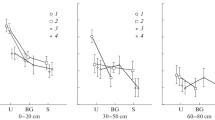Abstract
Within the area of a city, well known to be infected withCryptococcus neoformans, 170 soil samples have been for this fungus investigated. While six out of 50 soil samples coming from pigeon locations were positive for the fungus, none of the other 120 soil samples became positive from areas without pigeon locations. For future epidemiologic investigations a special method is suggested. The direct culture of the material was almost equivalent with the method of enrichment, while the animal experiment in comparison was less efficient. It is very probable, thatCryptococcus neoformans is no primary germ of the soil. Soil becomes secondarily contaminated by pigeons and their excrements.
Zusammenfassung
Innerhalb eines nachgewiesenermaßen mitCryptococcus neoformans (Cr. n.) infizierten Stadtgebietes wurden 170 Erdproben aufCr. n. untersucht. Während aus 6 von 50 Erdproben von Lokalisationen mit TaubenbesiedelungCr. n. nachgewiesen wurde, gelang dies bei keiner von 120 Proben ohne Taubenbesiedelung.
Diese Engebnisse werden so gedeutet, daß zumindest unter den hiesigen BedingungenCr. n. als primärer Erdbodensaprophyt praktisch nicht vorkommt. Die Besiedelung von Taubenkot mitCr. n. geschieht vielmehr bereits im Darmkanalspontan infizierter Tauben, oder durch Kontakt mit infiziertem Kot. Hierbei gelangensekundär auch Kryptokokken in den Erdboden.
Für künftige epidemiologische Untersuchungen wird eine Nachweismethodik empfohlen, die den Direktausstrich des in phys.-Kochsalzlösung suspendierten Untersuchungsmaterials auf Negersaat-Kreatinin-Antibiotika-Diphenylagar, seine Anreicherung in diphenylhaltiger (0,002 %) Bierwürze und den Tierversuch an der weißen Maus umfaßt. Mit dieser Methodik ist beim Vorhandensein von mindestens 10Cr. n. -Zellen in 1 g untersuchtem Ausgangsmaterial der Nachweis des Erregers zu erwarten.
Halbquantitative Antrocknungsversuche vonCr. n. (ein stark und ein nahezu unbekapselter Stamm, zwei verschiedene Antrocknungsmethoden) an sterilen Seesand zeigten, daß selbst die unter direkter Einwirkung von Sonnenlicht angetrockneten Kryptokokken weitgehend überlebten.
Die Direktkultur war dem Anreicherungsverfahren nahezu gleichwertig, während sich der Tierversuch im Vergleich dazu als weit weniger leistungsfähig erwies. Unter Hinweis auf frühere Untersuchungen wird betont, daß auf den Tierversuch dennoch nicht verzichtet werden sollte.
Similar content being viewed by others
Literatur
Ajello, L. (1956) Soil as natural reservoir for human pathogenic fungiScience 123:876–879.
Derselbe (1958) Occurrence of Cryptococcus neoformans in soilsAmer. J. Hyg. 67:72–77.
Böhm, K. H. (1967) Ein modifiziertes Plattenausstrichverfahren zur routinemäßigen Bestimmung der assimilatorischen Eigenschaften von Hefen in der mykologischen Diagnostik.Zbl. Bakt. I. Orig. 204:283–288.
Böhm, K. H., I. S. Abdallah, G. Trautwein &W. Bisping (1967) Nachweis vonCryptococcus neoformans in TaubenkotZbl. Vet. Med. B. 14:419–431.
Emmons, C. W. (1951) Isolation ofCryptococcus neoformans from soilJ Bact. 62:685–690.
Emmons, C. W. (1954) The significance of saprophytism in the epidemiology of the mycoses.Transact. N. Y. Acad. Sci. 17, Ser. II:157–166.
Frey, D. &E. B. Durie (1964) The isolation ofCryptococcus neoformans (Torula histolytica) from soil in New Guinea and pigeon droppings in Sidney, New South WalesMed. J. Aust. 1:947–949.
Littman, M. L. &R. Borok (1968) Relation of the pigeon to cryptocccocosis: Natural carrier state, heat resistance and survival ofCryptococcus neoformans.Mycopath. Mycol. appl. 35:329–345.
McDonough, E. S., L. Ajello, R. J. Ausherman, A Balows, J. T. McClellan &S. Brinkman (1961) Human pathogenic fungi recovered from soil in an aerea endemic for North American Blastomycosis.Amer. J. Hyg. 73:75–83.
Silva, M. E. (1960) Occurrence ofCryptococcus neoformans andMicrosporum gypseum in soils of Bahia, Brazil.Bol. Fund. Goncsclo Moniz 17:1–14.
Sotgiu, G., A. Mazzoni, A. Mantovani, L. Ajello &J. Palmer (1966) Survey of soils for human pathogenic fungi from the Emilia-Romanga region of Italy. II. Isolation ofAllescheria boydii, Cryptococcus neoformans andHistoplasma capsulatum.Amer. J. Epidemiol. 83:329–337.
Staib, F. (1963) Zur Widerstandsfähigheit vonCryptococcus neoformans gegen Austrocknung und hohe Temperaturen.Arch. Mikrobiol. 44:323–333.
Swatek, F. E., J. W. Wilson &D. T. Omieczynski (1967) Direct plate isolation method forCryptococcus neoformans from the soil.Mycopath. Mycol. appl. 32:129–140.
Weiland, E., K. H. Böhm &I. S. Abdallah (1968) Zum Vorkommen vonCryptococcus neoformans in TaubenBerlin. München. tierärztl. Wschr. 81:409–410.
Author information
Authors and Affiliations
Additional information
Die Untersuchungen wurden dankenswerterweise durch Mittel des Bundesministers für Ernährung, Landwirtschaft und Forsten gefördert.
Rights and permissions
About this article
Cite this article
Böhm, K.H., Weiland, E., Abdallah, I.S. et al. Untersuchcungen zum Verhalten von Cryptococcus Neoformans in Erde. Mycopathologia et Mycologia Applicata 42, 57–63 (1970). https://doi.org/10.1007/BF02051826
Received:
Issue Date:
DOI: https://doi.org/10.1007/BF02051826



